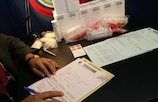WADA 2013 list of prohibited substances
Monday, January 7, 2013
Article summary
The World Anti-Doping Agency's new list of prohibited substances and methods came into effect on 1 January 2013, with several changes to the existing regulations.
Article top media content

Article body
The World Anti-Doping Agency has issued a new list of prohibited substances and methods, which came into effect on 1 January 2013.
List of prohibited substances 2013
The Prohibited List – which can be found in the supporting documentation on the right of the page – specifies substances and methods prohibited in sport. Implementation of the List is mandatory for organisations that have adopted the World Anti-Doping Code.
The 2013 list contains some changes compared to the 2012 list. It should be noted that with regards to prohibited substances:
• In category "S0. Non-approved substances" it has been clarified that veterinary products only refer to substances not approved for human use.
• In section "S3. Beta2-agonists" the permitted inhaled dose of formoterol has increased to 54 micrograms over 24 hours with a corresponding increase of the urinary threshold to 40 ng/mL.
• In addition, for stimulants falling under class S6, it has been confirmed that all optical isomers (d- and l-) where relevant, are prohibited.
With regards to prohibited methods, the definition of Gene Doping (section "M 3.1") has been reworded.
Impact of these changes on Therapeutic Use Exemption (TUE) procedure
Despite changes to the Prohibited List, UEFA's procedure for granting TUEs remain the same as in 2012. Players participating in UEFA competitions, or in senior-level international friendly matches, who have to use a prohibited substance or method for therapeutic purposes must request prior authorisation from UEFA.
TUE application forms must be duly completed and signed by the player and their doctor, and should then be sent with any relevant supporting documentation to the UEFA Anti-Doping Unit. Only in well founded and documented cases of medical emergency, players can apply for TUE after the prohibited substance has been administered, and before the TUE was granted by UEFA. For more details on the TUE process, in particular for asthma treatment and recognition principles for TUEs previously granted by National Anti-doping Organizations (NADOs), please refer to document "Guide to the WADA Prohibited List and TUEs" published in the TUE section on the right of the page.
The circular letter sent in December to all national associations and to clubs currently participating in UEFA competitions, gives more details on the 2013 Prohibited List. It can also be found in the supporting documentation section on this page.
